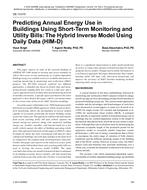Description
This paper reports on some of the research findings of ASHRAE RP-1404 meant to develop and assess methods by which short-term in-situ monitoring of weather-dependent building energy use could be used as a workable alternative to yearlong monitoring in monitoring and verification (M&V) projects. The RP-1404 research explored two different approaches: a detailed one based on hourly data and monitoring periods ranging from two weeks to a full year, and a coarse approach based on daily data and monitoring periods in monthly increments. A specific aspect pertinent to the latter approach is described in this paper, which is an advancement to the current state of the art for M&V baseline modeling. Anearlier paper (Abushakra et al. 1999) had proposed the hybrid inverse model (HIM) approach, which, based on shortterm monitoring, allows the development of inverse models capable of accurately predicting the hourly building energy use for the whole year. The approach combines the information from recent yearlong utility bill data (which captures the annual energy-use pattern) along with monitored building energy use, weather variables, and internal loads for a few weeks (which capture the effect of building operating schedules). This approach (referred to in this paper asHIM-D,where D stands for daily) has been reevaluated with data for three commercial buildings, but with data summed at the daily level as compared to the original study involving hourly timescale. Further, this paper also reports on the relative accuracy of the historic utility bill method where only yearlong utility bills are used to develop the inverse model (UBIM). The study concludes that about one month of monitored data is adequate in developing accurate inverse models, and that monitoring could be done at any time of the year. Further, it was found that there is a significant improvement in daily model prediction accuracy in using some amount of monitored data for developing the inverse model. Though inverse utility bill analysis is a well known approach, this paper demonstrates that complementing utility bill data with short-term monitoring will improve the accuracy of M&V baseline modeling methods requiring daily energy-use predictions.
Product Details
- Published:
- 2013
- Number of Pages:
- 12
- File Size:
- 1 file , 3.5 MB
- Product Code(s):
- D-DE-13-015
- Note:
- This product is unavailable in Russia, Belarus




